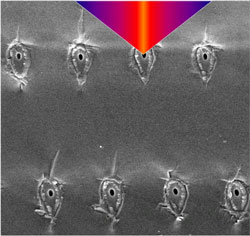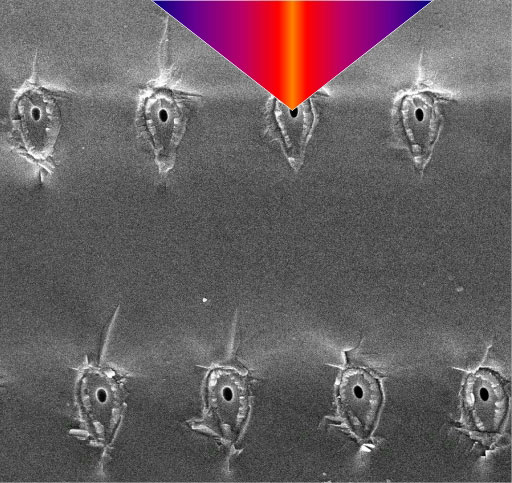Precision Microexplosions
If you wish your water would boil faster, imagine heating a material at 1018 degrees per second–a new record reported in the 28 April PRL. Using an ordinary laser and standard techniques, a team focused light energy into a sapphire crystal, igniting microscopic explosions. They then employed some physics reasoning and computer simulations to calculate, for the first time, the pressure, temperature, and heating rate of a microexplosion. The pressure generated was comparable to that caused by ultra-powerful lasers or chemical explosives and might help researchers study material properties at extreme conditions using a simple set-up.
Aside from the satisfaction inherent in crushing things, subjecting materials to extremely high pressures helps researchers study nuclear reactions and exotic states of matter such as might occur in planetary cores. Ideally they would like a tabletop method for generating precisely known and very high pressures. For the past decade researchers have used ultrashort (femtosecond) pulses from common lasers to etch patterns and channels into crystals for routing light, or as elements in light-emitting devices. But no one had tried to carefully determine the blast conditions. “People knew there must be high energies, but the focus was on characterizing the type of damage produced,” says Chris Schaffer of Cornell University.
Prior estimates of the pressure and heat unleashed by these explosions were fairly crude, says Saulius Juodkazis of Hokkaido University in Japan, part of an international team that has now determined exactly what was happening in these little fireballs. The researchers used an established technique for focusing ultrashort pulses in microexplosion experiments. They blasted a series of holes into a sapphire crystal, which they then sliced like a loaf of bread to measure the cross-sections of the exploded regions. Each blast zone consisted of a hole surrounded by a teardrop-shaped region of glassy sapphire, which had been superheated to plasma and compressed by a shockwave.
To piece together the explosion’s properties the group combined the principles of mass and energy conservation with the measured dimensions of the blast regions. Each pulse had an energy of 20-120 nanojoules. Most of that energy was absorbed in a small volume of the sapphire, creating dense plasma that powered an expanding shockwave. The volume of the absorbing region and the energy of the pulse determine the shockwave’s initial pressure. For a 100 nanojoule pulse, the absorbing region was an estimated 0.01 cubic microns, which gives a calculated pressure of 10 terapascals (tera = 1012), about 20 times the pressure at the Earth’s core. According to the team’s computer simulations, the temperature was 500,000 degrees Kelvin, with a heating rate of 1018 degrees per second, the highest rate ever measured or calculated, the authors say.
“What no one had really done was take a real simple model and try to estimate where the energy is being deposited and what effect it’s having on the material, to try to back out what the conditions were” in the explosion, says Schaffer. ”I’m kind of kicking myself for not having thought to put that together before.”
The technique may now offer a new window onto the conditions inside planets. Powerful lasers have created pressures up to about 50 terapascals, but those are located at specialized facilities. “This is people doing tabletop experiments and getting up to these massive, massive pressures,” says Paul McMillan of University College London. With microexplosions, Schaffer adds, “the tricky thing is, these conditions are only there for a few tens of picoseconds, but at least it gives the possibility.”
–JR Minkel
JR Minkel is a freelance science writer in New York City.





